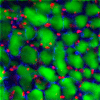Biophysical determinants of alveolar epithelial plasma membrane wounding associated with mechanical ventilation
- PMID: 23997173
- PMCID: PMC3798764
- DOI: 10.1152/ajplung.00437.2012
Biophysical determinants of alveolar epithelial plasma membrane wounding associated with mechanical ventilation
Erratum in
- Am J Physiol Lung Cell Mol Physiol. 2014 Apr 15;306(8):L808
Abstract
Mechanical ventilation may cause harm by straining lungs at a time they are particularly prone to injury from deforming stress. The objective of this study was to define the relative contributions of alveolar overdistension and cyclic recruitment and "collapse" of unstable lung units to membrane wounding of alveolar epithelial cells. We measured the interactive effects of tidal volume (VT), transpulmonary pressure (PTP), and of airspace liquid on the number of alveolar epithelial cells with plasma membrane wounds in ex vivo mechanically ventilated rat lungs. Plasma membrane integrity was assessed by propidium iodide (PI) exclusion in confocal images of subpleural alveoli. Cyclic inflations of normal lungs from zero end-expiratory pressure to 40 cmH2O produced VT values of 56.9 ± 3.1 ml/kg and were associated with 0.12 ± 0.12 PI-positive cells/alveolus. A preceding tracheal instillation of normal saline (3 ml) reduced VT to 49.1 ± 6 ml/kg but was associated with a significantly greater number of wounded alveolar epithelial cells (0.52 ± 0.16 cells/alveolus; P < 0.01). Mechanical ventilation of completely saline-filled lungs with saline (VT = 52 ml/kg) to pressures between 10 and 15 cmH2O was associated with the least number of wounded epithelial cells (0.02 ± 0.02 cells/alveolus; P < 0.01). In mechanically ventilated, partially saline-filled lungs, the number of wounded cells increased substantially with VT, but, once VT was accounted for, wounding was independent of maximal PTP. We found that interfacial stress associated with the generation and destruction of liquid bridges in airspaces is the primary biophysical cell injury mechanism in mechanically ventilated lungs.
Keywords: epithelial wounding; injury; lung mechanics.
Figures



References
-
- Acute Respiratory Distress Syndrome Network. Ventilation with lower tidal volumes compared with traditional tidal volumes for acute lung injury, and the acute respiratory distress syndrome. The Acute Respiratory Distress Syndrome Network. N Engl J Med 342: 1301–1308, 2000 - PubMed
-
- Albert RK. The role of ventilation-induced surfactant dysfunction and atelectasis in causing acute respiratory distress syndrome. Am J Respir Crit Care Med 185: 702–708, 2012 - PubMed
-
- Amato MB, Barbas CS, Medeiros DM, Schettino Gde P, Lorenzi Filho G, Kairalla RA, Deheinzelin D, Morais C, Fernandes Ede O, Takagaki TY. Beneficial effects of the “open lung approach” with low distending pressures in acute respiratory distress syndrome A prospective randomized study on mechanical ventilation. Am J Respir Crit Care Med 152: 1835–1846, 1995 - PubMed
-
- Belete HA, Godin LM, Stroetz RW, Hubmayr RD. Experimental models to study cell wounding and repair. Cell Physiol Biochem 25: 71–80, 2000 - PubMed
Publication types
MeSH terms
Grants and funding
LinkOut - more resources
Full Text Sources
Other Literature Sources
Research Materials
Miscellaneous

